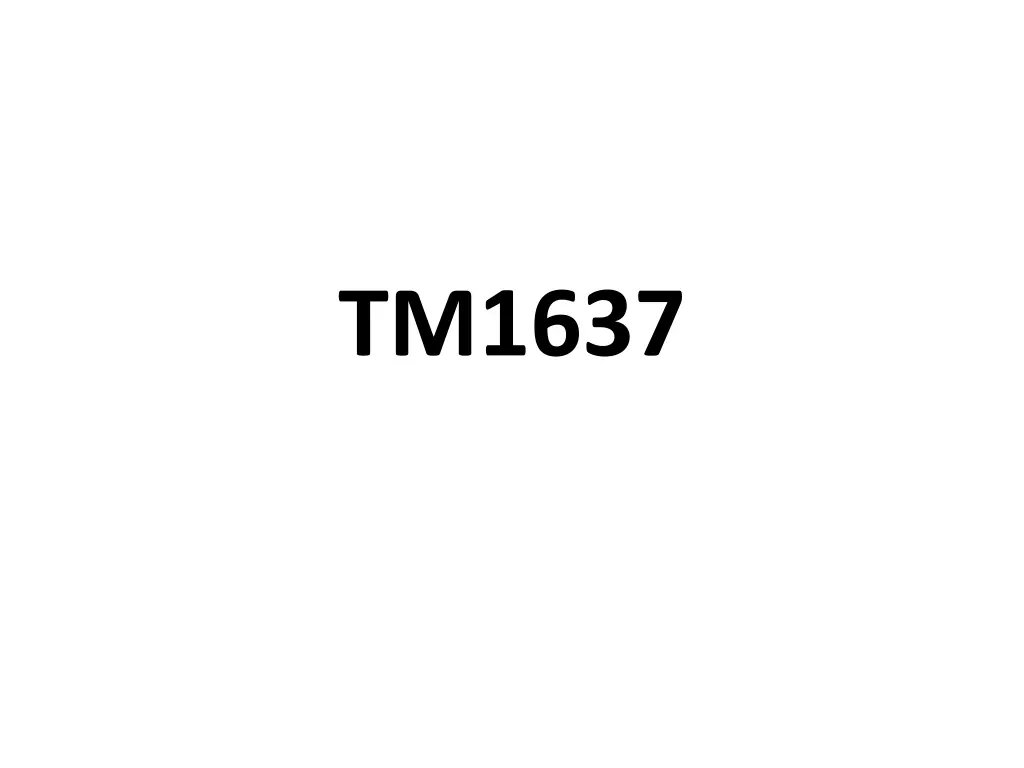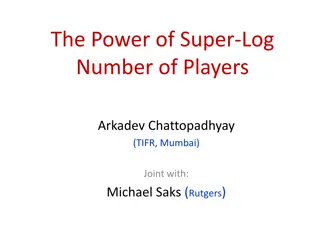
Interactive TM1637 Display Programming Guide
Learn how to program the TM1637 display module to control brightness, display numbers, and create interactive displays using Arduino. Follow step-by-step instructions with code snippets and monitor feedback to master the TM1637 display programming.
Download Presentation

Please find below an Image/Link to download the presentation.
The content on the website is provided AS IS for your information and personal use only. It may not be sold, licensed, or shared on other websites without obtaining consent from the author. If you encounter any issues during the download, it is possible that the publisher has removed the file from their server.
You are allowed to download the files provided on this website for personal or commercial use, subject to the condition that they are used lawfully. All files are the property of their respective owners.
The content on the website is provided AS IS for your information and personal use only. It may not be sold, licensed, or shared on other websites without obtaining consent from the author.
E N D
Presentation Transcript
Kijelz intenzitsa // This program changes the brighness // on the TM1637 diaplay. // The current brightness is shown on the Serial Monitor. void loop() { for (int i=0; i<8; i++){ display.setBrightness(i); display.showNumberDec(99); Serial.print("Current brightness of the display: "); Serial.println(i); Serial.println(""); delay(1000); } } #include <TM1637Display.h> #define CLK 2 #define DIO 3 TM1637Display display(CLK, DIO); void setup() { Serial.begin(9600); }
Szmok a kijelzn // This program sends numbers to the display. // Numbers are shown on the Serial Monitor. // Maximal numbers are tested. display.showNumberDec(10000); Serial.println("Number sent to diaplay: 10000"); Serial.println("Shown: 0000"); Serial.println(""); delay(200); display.showNumberDec(32767); Serial.println("Number sent to diaplay: 32767"); Serial.println("Shown: 2767"); Serial.println(""); delay(200); display.showNumberDec(32768); Serial.println("Number sent to diaplay: 32768"); Serial.println("Shown: 2768"); Serial.println(""); delay(200); #include <TM1637Display.h> #define CLK 2 #define DIO 3 TM1637Display display(CLK, DIO); void setup() { display.setBrightness(1); Serial.begin(9600); } void loop() { display.showNumberDec(9999); Serial.println("Number sent to diaplay: 9999"); Serial.println("Shown: 9999"); Serial.println(""); delay(500);
Szmok a kijelzn display.showNumberDec(32769); Serial.println("Number sent to diaplay: 32769"); Serial.println("Shown: 2767"); Serial.println(""); delay(200); display.showNumberDec(32770); Serial.println("Number sent to diaplay: 32770"); Serial.println("Shown: 2766"); Serial.println(""); delay(200); display.showNumberDec(65535); Serial.println("Number sent to diaplay: 65535"); Serial.println("Shown: -1"); Serial.println(""); delay(200); display.showNumberDec(65536); Serial.println("Number sent to diaplay: 65536"); Serial.println("Shown: 0"); Serial.println(""); delay(200); display.showNumberDec(65537); Serial.println("Number sent to diaplay: 65537"); Serial.println("Shown: 1"); Serial.println(""); delay(200); while(true); }
Szmll 0-10 void loop() { for (int counter=0; counter<11; counter++){ display.showNumberDec(counter); Serial.print("Display is ON. Number on the display is: "); Serial.println(counter); delay(800); display.clear(); Serial.println("Display is OFF."); Serial.println(""); delay(200); } while(true); } // This program counts from 0 to 10 on the // display and between each count clears the // display. Everything can be followed on the // Serial Monitor. #include <TM1637Display.h> #define CLK 2 #define DIO 3 TM1637Display display(CLK, DIO); void setup() { display.setBrightness(1); Serial.begin(9600); }
Tetszleges karakterek // This program creates custom characters that turns on and off all segments. // The display is programmed in a segment-by-segment fashion. #include <TM1637Display.h> #define CLK 2 #define DIO 3 TM1637Display display(CLK, DIO); uint8_t all_on[] = {0xff, 0xff, 0xff, 0xff}; // uint8_t is the same as byte uint8_t blank[] = {0x00, 0x00, 0x00, 0x00}; uint8_t degree[] = {SEG_A | SEG_B | SEG_F | SEG_G}; uint8_t celsius[] = {SEG_A | SEG_D | SEG_E | SEG_F}; uint8_t done[] = { SEG_B | SEG_C | SEG_D | SEG_E | SEG_G, // d SEG_A | SEG_B | SEG_C | SEG_D | SEG_E | SEG_F, // O SEG_C | SEG_E | SEG_G, // n SEG_A | SEG_D | SEG_E | SEG_F | SEG_G // E }; void setup() { display.setBrightness(1); Serial.begin(9600); }
Tetszleges karakterek void loop() { for (int i=0; i<4; i++){ display.setSegments(degree,1,i); delay(500); display.setSegments(blank); } for (int i=3; i>-1; i--){ display.setSegments(degree,1,i); delay(500); display.setSegments(blank); } display.setSegments(done,4,0); delay(1000); display.setSegments(blank); delay(1000); } https://people.vts.su.ac.rs/~pmiki/_DALJINSKA_NASTAVA_MIKROKONTROLERI/19.05/ degreeC.mp4
Joystick #include <TM1637Display.h> #define CLK 2 #define DIO 3 TM1637Display display(CLK, DIO); void loop() { if (analogRead(Y_pin)>100 && analogRead(Y_pin)<500){ currentNumber++; display.showNumberDec(currentNumber); delay(timeDelay); } if (analogRead(Y_pin)<100){ currentNumber = currentNumber + 10; display.showNumberDec(currentNumber); delay(timeDelay); } if (analogRead(Y_pin)>550 && analogRead(Y_pin)<900){ currentNumber--; display.showNumberDec(currentNumber); delay(timeDelay); } if (analogRead(Y_pin)>900){ currentNumber = currentNumber - 10; display.showNumberDec(currentNumber); delay(timeDelay); } const int SW_pin = 7; // digital pin connected to SW const int X_pin = 0; // analog pin connected to VRx const int Y_pin = 1; // analog pin connected to VRy int currentNumber; int timeDelay = 250; void setup() { display.setBrightness(1); digitalWrite(SW_pin, HIGH); Serial.begin(9600); display.showNumberDec(currentNumber); }
Joystick if (analogRead(X_pin)<100){ currentNumber = -999; display.showNumberDec(currentNumber); delay(timeDelay); } if (analogRead(X_pin)>900){ currentNumber = 999; display.showNumberDec(currentNumber); delay(timeDelay); } if (digitalRead(SW_pin)==LOW){ currentNumber = 0; display.showNumberDec(0); delay(timeDelay); } } https://people.vts.su.ac.rs/~pmiki/_DALJINSKA_NASTAV A_MIKROKONTROLERI/19.05/joystick.mp4
1248 a kijelzn // This program counts from 0 to 10 on the display and // between each count clears the display. // Everything can be followed on the serial Monitor. void loop() { // Selectively set different digits data[0] = display.encodeDigit(1); data[1] = display.encodeDigit(2); data[2] = display.encodeDigit(4); data[3] = display.encodeDigit(8); display.setSegments(data); delay(1000); #include <TM1637Display.h> #define CLK 2 #define DIO 3 TM1637Display display(CLK, DIO); uint8_t all_on[] = {0xff, 0xff, 0xff, 0xff}; uint8_t data[] = { 0xff, 0xff, 0xff, 0xff }; Serial.println(data[0]); Serial.println(data[1]); Serial.println(data[2]); Serial.println(data[3]); void setup() { display.setBrightness(1); display.setSegments(all_on); delay(1000); display.clear(); delay(1000); Serial.begin(9600); } while(true); } https://people.vts.su.ac.rs/~pmiki/_DALJINSKA_N ASTAVA_MIKROKONTROLERI/19.05/1248.mp4
Htrafel szmll 9999-0 void loop() { display.setBrightness(0x01); // display organization // data[0] data[1] data[2] data[3] data[3] = display.encodeDigit(count/1 % 10); data[2] = display.encodeDigit(count/10 % 10); data[1] = display.encodeDigit(count/100 % 10); data[0] = display.encodeDigit(count/1000 % 10); display.setSegments(data); //display.showNumberDec(count); if(count <= 0) { count = 9999; } else { count--; } delay(TEST_DELAY); } #include <TM1637Display.h> // Module connection pins (Digital Pins) #define CLK 2 #define DIO 3 // The amount of time (in milliseconds) // between tests #define TEST_DELAY 100 TM1637Display display(CLK, DIO); int count = 9999; uint8_t data[] = {0, 0, 0, 0}; void setup() { }
Play + htrafel szmll 500-0 void countdown(){ for(int i=500; i>0; i--){ display.showNumberDec(i, false, 4, 0); delay(40); } } #include <TM1637Display.h> const uint8_t OFF[] = {0, 0, 0, 0}; const uint8_t PLAY[] = {B01110011, B00111000, B01011111, B01101110}; TM1637Display display(2, 3); void displayText(){ display.setSegments(PLAY); delay(2000); } void setup(){ display.setBrightness(1); display.setSegments(OFF); } void loop(){ displayText(); countdown(); }
Play + htrafel szmll 09:59-00:00 void countdown(){ // Calculate the time remaining unsigned long timeRemaining = timeLimit - millis(); while (timeRemaining > 0){ int seconds = numberOfSeconds(timeRemaining); int minutes = numberOfMinutes(timeRemaining); // Display seconds in the last two places display.showNumberDecEx(seconds, 0, true, 2, 2); // Display minutes in hte first two places with colon display.showNumberDecEx(minutes, 0x80>>1, true, 2, 0); // Update the time remaining timeRemaining = timeLimit - millis(); } } void displayText(){ display.setSegments(PLAY); delay(2000); } void loop(){ displayText(); countdown(); } // Mcros to retrieve the fractional seconds and minute parts // of a time supplied inms #define numberOfSeconds(_time_) ((_time_ / 1000) % 60) #define numberOfMinutes(_time_) (((_time_ / 1000) / 60) % 60) #include <TM1637Display.h> // CONSTANTS const uint8_t OFF[] = {0, 0, 0, 0}; // The byte order is .gfedcba const uint8_t PLAY[] = {B01110011, B00111000, B01011111, B01101110}; TM1637Display display(2, 3); // 1 hour in ms unsigned long timeLimit = 600000; void setup(){ Serial.begin(9600); display.setBrightness(1); display.setSegments(OFF); }
Mtrikszos billenyzet 1. plda #include <Keypad.h> void setup(){ Serial.begin(9600); } void loop(){ char customKey = customKeypad.getKey(); if (customKey){ Serial.print("Key pressed: "); Serial.println(customKey); Serial.println(""); } } const byte ROWS = 4; //four rows const byte COLS = 4; //four columns // Define the Keymap char hexaKeys[ROWS][COLS] = { {'1','2','3','A'}, {'4','5','6','B'}, {'7','8','9','C'}, {'*','0','#','D'} }; byte rowPins[ROWS] = {13, 12, 11, 10}; byte colPins[COLS] = {8, 7, 6, 5}; //initialize an instance of class NewKeypad Keypad customKeypad = Keypad( makeKeymap(hexaKeys), rowPins, colPins, ROWS, COLS);
Mtrikszos billenyzet 2. plda #include <Keypad.h> int secretCode[]={1,2,3,4}; int myGuess[]={0,0,0,0}; int counter = 0; int myGoodChoices=0; const byte ROWS = 4; //four rows const byte COLS = 4; //four columns //define the cymbols on the buttons of the keypads char hexaKeys[ROWS][COLS] = { {'1','2','3','A'}, {'4','5','6','B'}, {'7','8','9','C'}, {'*','0','#','D'} }; byte rowPins[ROWS] = {13, 12, 11, 10}; //connect to the row pinouts of the keypad byte colPins[COLS] = {8, 7, 6, 5}; //connect to the column pinouts of the keypad //initialize an instance of class NewKeypad Keypad customKeypad = Keypad( makeKeymap(hexaKeys), rowPins, colPins, ROWS, COLS); void setup(){ Serial.begin(9600); }
Mtrikszos billenyzet 2. plda for (int i=0; i<4; i++){ Serial.print("Secret: "); Serial.print(secretCode[i]); Serial.print(" "); Serial.print("My guess: "); Serial.print(myGuess[i]-48); Serial.println(""); } Serial.println(""); for (int j=0; j<4; j++){ if (secretCode[j]==myGuess[j]-48){ myGoodChoices++; } Serial.print("myGoodChoices= "); Serial.println(myGoodChoices); } void loop(){ myGoodChoices = 0; char customKey = customKeypad.getKey(); if (customKey != NO_KEY){ myGuess[counter]=customKey; Serial.println(customKey); counter++; //Serial.print("Current counter value is: "); //Serial.println(counter); if (counter==4){ Serial.println(""); Serial.print("The four digit guess is: "); for(int i=0; i<4; i++){ Serial.print(char(myGuess[i])); //Serial.println(myGuess[i]); Serial.print(" "); } Serial.println(""); Serial.println(""); counter=0; if (myGoodChoices==4){ Serial.println(""); Serial.println("Good!"); } else{ Serial.println("Miss!"); } Serial.println(""); } } }
Mtrikszos billenyzet 3. plda #include <Keypad.h> //initialize an instance of class NewKeypad Keypad customKeypad = Keypad( makeKeymap(hexaKeys), rowPins, colPins, ROWS, COLS); int secretCode[]={1,2,3,4}; int myGuess[]={0,0,0,0}; boolean array_cmp; int counter = 0; int myGoodChoices=0; void setup(){ Serial.begin(9600); pinMode(2, OUTPUT); pinMode(3, OUTPUT); pinMode(4, OUTPUT); } void loop(){ char customKey = customKeypad.getKey(); if (customKey>='0' && customKey<='9'){ Serial.println(customKey); Serial.println("Number"); Serial.println(""); digitalWrite(2, HIGH); delay(200); digitalWrite(2, LOW); } const byte ROWS = 4; //four rows const byte COLS = 4; //four columns //define the symbols on the buttons of the keypads char hexaKeys[ROWS][COLS] = { {'1','2','3','A'}, {'4','5','6','B'}, {'7','8','9','C'}, {'*','0','#','D'} }; byte rowPins[ROWS] = {13, 12, 11, 10}; //connect to the row pinouts of the keypad byte colPins[COLS] = {8, 7, 6, 5}; //connect to the column pinouts of the keypad
Mtrikszos billenyzet 3. plda if (customKey>='A' && customKey<='D'){ Serial.println(customKey); Serial.println("Letter"); Serial.println(""); digitalWrite(3, HIGH); delay(200); digitalWrite(3, LOW); } if (customKey=='*' || customKey=='#'){ Serial.println(customKey); Serial.println("Special character"); Serial.println(""); digitalWrite(4, HIGH); delay(200); digitalWrite(4, LOW); } }







